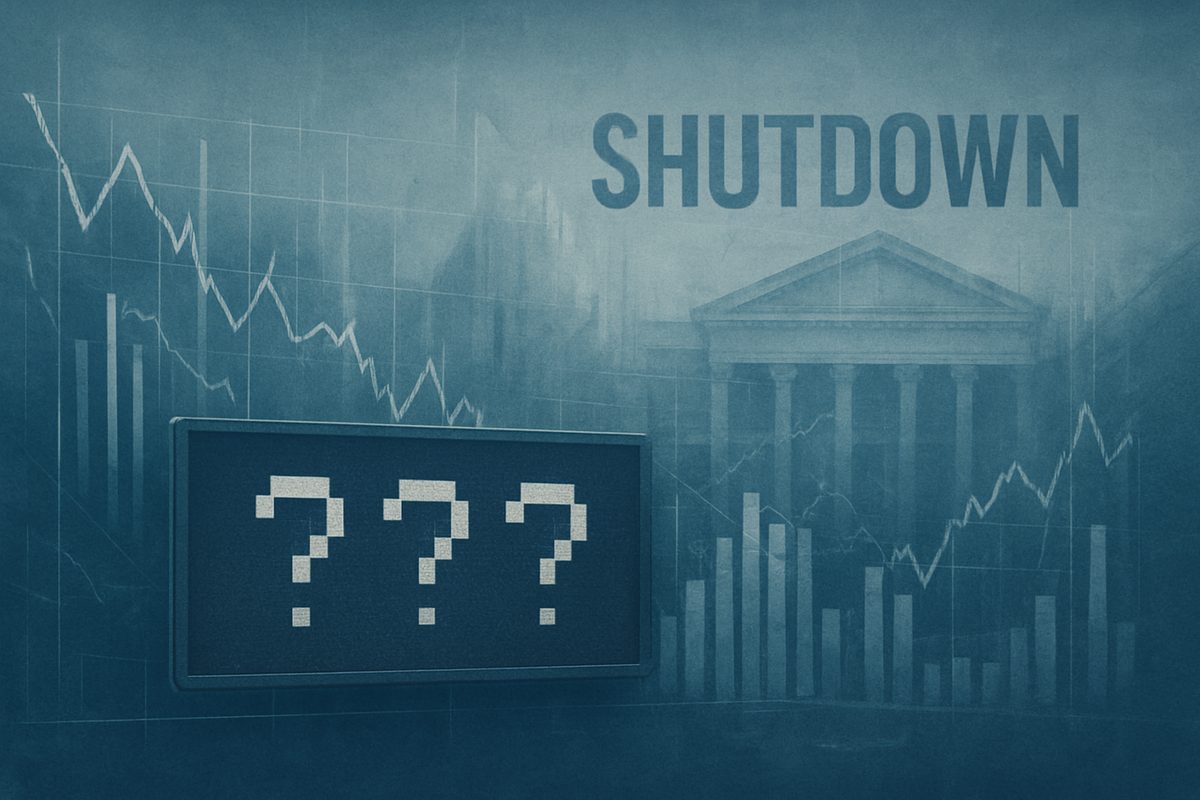
The United States government has recently emerged from its longest shutdown in history, a 43-day impasse that concluded on November 12, 2025. This protracted closure plunged the nation into an unprecedented "data vacuum," leaving financial markets, businesses, and policymakers "flying blind." As federal agencies scramble to resume operations and release a backlog of critical economic indicators, the financial world is bracing for a potential "data deluge" that is expected to trigger heightened market volatility and a significant recalibration of economic outlooks. The delay in these vital statistics has severely impacted investor confidence and complicated decision-making, obscuring the true state of the economy and forcing reliance on less comprehensive private-sector proxies.
The immediate implications of these eagerly anticipated economic data releases are profound. Market participants, who have been operating with limited visibility, will swiftly recalibrate their expectations for the U.S. economy. Weak data could confirm a slowdown narrative, potentially leading to market downturns, while surprisingly strong figures might revive hawkish monetary policy expectations, causing sharp shifts in asset prices. A crucial aspect of this data release is its impact on the Federal Reserve's monetary policy decisions, as the central bank has been operating without critical information on inflation and employment, making cautious interest rate adjustments a necessity.
Unpacking the Data Blackout: A Detailed Look at the Shutdown's Economic Scars
During the 43-day U.S. government shutdown, the collection, compilation, and release of crucial economic data were significantly disrupted. Agencies such as the Bureau of Labor Statistics (BLS), the U.S. Census Bureau, and the Bureau of Economic Analysis (BEA) suspended operations, leading to indefinite delays in the publication of vital reports like the U.S. jobs report (non-farm payrolls), Consumer Price Index (CPI), Producer Price Index (PPI), and Gross Domestic Product (GDP) reports. Data collection efforts were halted, and for some reports, particularly those relying on manual collection or household surveys, the data for October 2025 may be permanently lost or "impaired," creating lasting gaps in the economic record.
The timeline of events saw a complete cessation of most official economic reports during the shutdown. Upon its conclusion around November 12-13, 2025, statistical agencies immediately began the arduous task of clearing the backlog. Reports with data collected prior to the shutdown are generally the first to be processed, often within days. However, reports where data collection was interrupted or missed face longer delays, with subsequent months' releases also potentially pushed back. Key players and stakeholders in this process include the data-producing agencies themselves (BLS, Census Bureau, BEA, Department of Commerce) and the users of this data, such as the Federal Reserve, U.S. Congress, financial markets, businesses, investors, and consumers. The Federal Reserve, in particular, was left "flying blind," struggling to formulate monetary policy without accurate and timely information.
Initial market reactions to the anticipation of data releases were characterized by increased volatility and uncertainty. Investors became anxious about the missing "inflation compass" and other critical reports, leading to speculation about the Federal Reserve's next moves. While some reliance shifted to private sector proxies like the ADP employment report, credit card data, and various business surveys, these were generally considered "murkier" than official government statistics. Despite the data blackout, the S&P 500 showed some resilience during the shutdown, gaining 2% since October 1, 2025, with historical precedents suggesting that markets often recover quickly after a shutdown's resolution. However, the prospect of "gloomy economic data" once the shutdown ended fueled demand for safe-haven assets like gold.
Corporate Fortunes in the Wake of Data Releases: Winners and Losers
The post-shutdown environment, marked by the eventual release of backlogged and potentially surprising economic data, is poised to create distinct winners and losers among public companies. The Federal Reserve's ongoing deliberations on interest rate cuts, amidst underlying economic uncertainty, will be a critical factor.
Potential Winners:
- Rate-Sensitive Growth Sectors (upon confirmation of a softening economy and rate cuts): If the delayed data confirms a softening economy, increasing the likelihood of Federal Reserve interest rate cuts (potentially in December 2025), companies in growth-oriented sectors could benefit significantly.
- Real Estate Developers and Homebuilders: Companies like D.R. Horton (NYSE: DHI) and Lennar Corporation (NYSE: LEN) are highly sensitive to interest rates. Lower rates make mortgages more affordable, stimulating home purchases and construction.
- Consumer Discretionary: Companies such as Amazon (NASDAQ: AMZN) and Apple (NASDAQ: AAPL), which rely on consumer credit and increased spending, could see a boost if lower interest rates spur confidence and purchasing power.
- Technology Companies: Growth-oriented tech firms could experience renewed investor interest if lower rates make their future earnings more attractive.
- Healthcare Companies: "Defensive" stocks like Eli Lilly (NYSE: LLY) and Johnson & Johnson (NYSE: JNJ) have historically attracted investors seeking lower valuations and steadier earnings during periods of market caution and economic uncertainty.
- Highly Sophisticated Trading Firms: These firms, with advanced analytical capabilities, might leverage increased volatility and information asymmetry around data releases to generate profits through arbitrage and speculative strategies.
Potential Losers:
- Companies with High Debt Loads: If the eventual data reveals persistent inflation or a stronger-than-anticipated economy, the prospect of rate cuts could diminish. A "higher for longer" interest rate environment would significantly pressure companies with substantial debt due to elevated borrowing costs.
- Cyclical Industries (if data confirms slowdown):
- Manufacturing and Industrials: Companies like Caterpillar (NYSE: CAT) could face decreased demand for goods, supply chain disruptions, and reduced industrial activity if a confirmed economic slowdown emerges.
- Energy and Smaller Exploration & Production (E&P) Companies: A weaker-than-expected economic picture could dampen demand forecasts for commodities, capping price upside.
- Agricultural Commodity Traders and Producers: Firms such as Archer-Daniels-Midland (NYSE: ADM) and Bunge Global SA (NYSE: BG) face increased uncertainty regarding future crop prices and export demand.
- Financial Institutions: In a prolonged high-rate environment with dampening loan demand, banks might see reduced overall loan demand and increased default rates, despite initial benefits from higher net interest margins.
The current date of November 13, 2025, places markets at a critical juncture. The immediate "relief rally" observed as the shutdown concluded may give way to significant adjustments as actual data emerges. Surprising "good" data (strong economy/inflation) could diminish the likelihood of immediate Fed rate cuts, boosting companies that thrive in a strong economy but hurting highly leveraged firms. Conversely, "bad" data (weak economy/disinflation) would strengthen the case for Fed rate cuts, providing a boost to rate-sensitive sectors but potentially signaling declining corporate profits across the board. The Federal Reserve's interpretation of this data will be paramount, as any signals regarding their next move will trigger significant market movements across various asset classes.
Beyond the Numbers: Wider Significance and Lasting Echoes
The economic data releases following the U.S. government shutdown carry significant wider implications, profoundly impacting policymakers, industries, and the overall economy. This event underscores the modern economy's increasing reliance on timely and credible government statistics. In an era driven by data analytics and precision, the sudden absence or impairment of foundational government economic data leaves market participants and policymakers "operating a little bit blind," forcing greater reliance on less reliable private-sector proxies. This highlights the critical infrastructure that federal statistical agencies provide to the entire economic ecosystem.
The ripple effects of delayed or missing economic data are widespread. The Federal Reserve, heavily reliant on indicators like inflation and employment, faces significant challenges in guiding monetary policy, potentially leading to suboptimal policy choices or delayed actions. Businesses and investors, without reliable data, struggle with strategic planning, investment decisions, and risk assessment, leading to postponed investments and reduced consumer spending. Federal contractors face immediate cash flow problems, while financial services firms experience delays due to curtailed functions at regulatory bodies like the Securities and Exchange Commission (SEC) and the Department of Justice (DOJ).
From a regulatory and policy perspective, the shutdown creates significant backlogs and uncertainty. Agencies operate with curtailed functions, suspending registration reviews, examinations, and new rulemaking. Post-shutdown, firms must anticipate a surge in enforcement actions and an accelerated rulemaking schedule. The lack of critical data also makes the Federal Reserve's job of managing the economy extremely challenging, particularly when trying to balance inflation and employment goals. Historically, while short shutdowns have had muted effects on the stock market, prolonged events, like the recent 43-day closure, lead to more significant economic consequences and can leave "lasting scars," including permanent loss of economic activity and impaired data. The current context of a protracted shutdown intensifies all these impacts, posing significant challenges for the Federal Reserve and potentially eroding international trust in U.S. economic stewardship.
The Road Ahead: Navigating Post-Shutdown Economic Currents
The resolution of the longest U.S. government shutdown presents a complex landscape of short-term recoveries, lingering challenges, and the imperative for strategic adaptation across various sectors. The "data blackout" during the shutdown has created a permanent gap in historical data, with key reports for October 2025, such as nonfarm payrolls and the Consumer Price Index, unlikely to be fully released. This means that future economic assessments may continue to be challenging due to incomplete information.
In the short term, a "relief rally" in financial markets is anticipated, driven by renewed investor confidence. The disbursement of back pay to furloughed federal employees is expected to provide a rapid boost to consumer spending. However, the shutdown has already left a clear dent in near-term economic growth, with the Congressional Budget Office (CBO) estimating a reduction in real GDP growth for the affected quarter. While much of this lost output is expected to be recovered, some economic activity, potentially billions of dollars, will be permanently lost.
Looking to the long term, the recurring nature of government shutdowns introduces systemic political risk that financial markets are increasingly pricing in. This can erode international trust in the U.S.'s economic stewardship. Businesses, especially those reliant on federal contracts or regulatory approvals, are compelled to implement robust contingency plans, including diversifying revenue streams, building cash reserves, and enhancing operational flexibility.
Market opportunities and challenges will emerge as the "data deluge" hits. Historically, the resolution of government shutdowns tends to support equities, with cyclical sectors like financials and industrials potentially seeing an uplift. However, the imminent release of backlogged data could spur additional market volatility as investors digest potentially surprising figures. The Federal Reserve's policy stance remains a key uncertainty, as the data blackout has created a "blind spot" for determining the appropriate path for interest rates.
Potential scenarios include a swift recovery if economic activity rebounds quickly and data backlogs are managed, providing the Fed with sufficient information. Conversely, a scenario of prolonged uncertainty could emerge if the economic scarring is more significant than anticipated, with consumer confidence and business investment remaining subdued. A third, more concerning scenario, involves recurring political gridlock, where future funding deadlines lead to renewed shutdown risks, embedding systemic risks into investment strategies.
Navigating the New Normal: A Comprehensive Wrap-up for Investors
The 43-day U.S. government shutdown, concluding on November 12, 2025, has left an indelible mark on the economy, characterized by significant GDP reduction, a permanent loss of economic activity, and a critical "data blackout." The suspension and delay of key economic reports, particularly the October jobs report and CPI figures, have created a "fog of uncertainty" that will continue to challenge policymakers and investors alike. While a "relief rally" is likely in the immediate aftermath, the market is now bracing for a "data deluge" that could introduce substantial volatility as weeks of economic news are digested.
Moving forward, the market will be heavily influenced by the Federal Reserve's assessment of the incoming data, especially regarding potential interest rate adjustments at its December meeting. The shutdown has magnified existing economic challenges, such as inflation and trade tensions, by obscuring the true state of the economy. This prolonged period of uncertainty and the potential for recurring political impasses underscore the need for resilience and adaptability in investment strategies.
For investors, the coming months demand vigilant attention to several key indicators:
- Delayed Economic Data Releases: Closely monitor the backlog of economic reports, particularly the October jobs report, CPI figures, and consumer spending data. These will provide crucial insights into the economy's performance during and immediately after the shutdown.
- Federal Reserve's Stance: The Fed's interpretation of the incoming data and its implications for monetary policy will be a primary focus.
- Consumer and Business Sentiment: Watch for a rebound in consumer confidence and any shifts in business investment and hiring plans.
- Sector-Specific Performance: Observe sectors heavily exposed to government contracts (e.g., defense, IT services) and those affected by travel disruptions.
- Future Budget Negotiations: While the current funding agreement extends through January 30, 2026, the underlying political divisions remain. Investors should stay alert to future budget deadlines.
- Inflation and Fixed Income Markets: Given the uncertainty and the Fed's data-dependent approach, observe inflation-linked products and U.S. Treasury yields, which typically react to political instability and economic outlook shifts. Gold, often a safe-haven asset, may also show continued volatility.
- Overall Market Volatility: Be prepared for potential periods of increased market volatility as new information is processed and the economy navigates the post-shutdown landscape.
The recent shutdown serves as a stark reminder of the critical role of timely and accurate economic data in maintaining market stability and fostering informed decision-making. Investors must remain agile, adapting their strategies to a potentially more volatile and less predictable economic environment.
This content is intended for informational purposes only and is not financial advice






